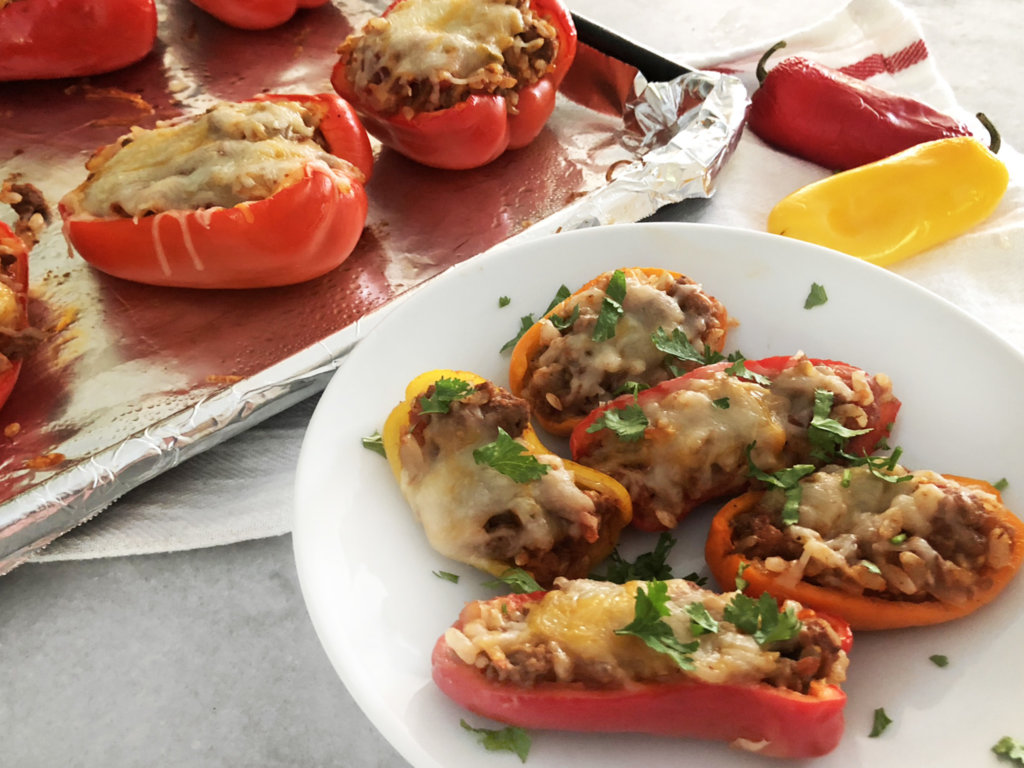
A “case of the Mondays” doesn’t necessarily have to be a bad thing. Research conducted by Johns Hopkins found that people are more likely to use Mondays as the day to start fresh and kick off health goals, such as eating plans or exercise regimes. And based on that research, The Monday Campaigns was founded. The non-profit public health initiative is associated with Johns Hopkins and both Columbia and Syracuse Universities. You may know their first campaign—Meatless Monday—but they’ve started a number of other programs.
We’ve partnered with The Monday Campaigns to bring Grok Nation readers new info each month to have healthier Mondays. Read the past Monday posts here.
How do you deal with children who are picky eaters? This is a common question at The Kids Cook Monday after-school classes, so we asked a mother who also works with families to guide better eating and a reduction of stress surrounding their food choices. Her name is Diana K. Rice, RD, LD, aka The Baby Steps Dietitian and the founder of Diana K. Rice Nutrition, LLC. One of the most common issues she deals with is how to get children who are picky eaters to try new foods.
To learn more about how to get your picky eaters to expand their palates, Diana answered some questions around trying more fruits and vegetables during the holidays.
What are some tips for getting your picky eaters to start eating more fruits and vegetables during the holidays and beyond?
The holidays can be a great time to introduce new foods! Whether you are cooking a special recipe that you only make once a year or dining at the home of friends or family who prepare meals different from your usual fare, your kids are likely to encounter foods they’ve never seen before. Use this time to share what’s so special about these foods. Talk about things such as how grandma has made the same green bean casserole every year since dad was a little boy and he always looks forward to it, or how a dish like maple-glazed carrots or sweet potato casserole is an extra-special way to enjoy those vegetables. Remember not to pressure kids to try something new, but talk about how much everyone else likes it and certainly model enjoying the food yourself. And of course, if there’s an opportunity for the kids to be involved in cooking these dishes, seize it!
How can you prepare over the weekend to help your family start each week on a healthier track?
Grocery shopping and meal prepping are so important, especially for busy families! If you can, try to make these tasks less of a chore and more like fun family activities. Ask older kids to suggest meals to make for the week, and kids of any age can go shopping with you. I certainly know how stressful it can be to bring kids along to the store with you when you’re just trying to get your shopping done and get out of there, but it can also be very fun when the kids get to choose some of the foods or push their own shopping carts. Personally, I have to steer my kids away from the produce section, or else they’ll want to buy too much!
Once you’re home, kids can help with meal prep as well, even if it’s just placing the veggies you’ve chopped into individual containers. Having healthy foods ready to go at the start of your week will make a huge difference in how your family eats as the week gets busier!
Prepping over the weekend makes it easier for your family to set aside Monday night as family cooking and dinner night. Research shows that if you start a habit on a Monday, you’re more likely to continue it throughout the week. Kids Cook Monday is a great way to get your kids in the kitchen and to encourage healthy behaviors during family mealtime.
How do you think that involving picky eaters in holiday meal prep will help them try new foods?
Getting kids involved in meal prep at any time of year has been shown to help them be more open to trying new foods, but because of all the special cooking that goes on during the holiday season, they’ll have extra opportunities to get involved and will likely be exposed to some foods they haven’t seen before. Another benefit is that they’ll see additional friends and family members preparing and enjoying these foods. I’ve certainly seen plenty of kids who are reluctant to try a food when mom or dad prepares it, but bring grandma into the mix and it’s a whole different story!
What are some easy ways you can involve picky kids in preparing holiday meals?
It’s important to help kids feel that they are part of the entire process. So, pull out a holiday cookbook and ask them to choose a recipe or bring them to the store and let them pick out the produce for a dish you’re planning, weigh it (even if it doesn’t need to be weighed!) and even carry it home. Tasks like these help the child develop a sense of ownership over the food even before you start cooking. Then, of course, find age-appropriate ways for the child to cook the new food with you, taste-testing along the way if they like. And when it comes time to serve the dish, make a big deal to the rest of the family about how your child helped!
All of this combined creates a positive experience for the child and entices them to eat the food along with the rest of the family. But keep in mind that most kids need many exposures to a food in order to ultimately accept it, so if they don’t choose to eat it that day, it just means you might need to prepare the same food a few more times in the future.
How can you get your family cooking and eating a healthy meal together after a weekend of indulging?
The best thing to do is to not make a big deal over the difference between “indulgent” meals and healthy ones. In my family, we certainly eat things like fried foods or dishes with fewer vegetables when we’re on the go on the weekends. They’re convenient and my husband and I enjoy these kinds of foods from time to time, too! But I don’t worry about it at all because I know we’ll be back to eating the balanced meals I plan when the work week starts up again.
Setting aside some time to cook a healthy meal together, such as on Monday nights, is a great way to set the tone for the week. And I make a point to show just as much excitement for a weeknight dish like roasted broccoli as I did for the French fries we enjoyed over the weekend. It’s all delicious food, and I want my kids to know that both of these foods play a role in our overall healthy diets.
As the mom of two very young daughters, how do you make sure they’ll be open to eating different foods?
It’s very important to me to never pressure them to try any food, not even one bite. I want them to feel relaxed and comfortable around food and eliminating pressure is an important part of that (research shows it doesn’t work, anyway). I use something of a two-fold strategy to introduce new foods while also providing nutritious foods that they are likely to eat. Some of our go-to produce items are broccoli, carrots, peppers, peas, sweet potatoes and pretty much any type of fruit. So I’ll incorporate at least one of these items into each of our dinners. Then a few times a week, I’ll have them help me prepare something new or something we’ve made in the past that wasn’t a hit with them. Often this is an item they’ve helped me select at the store. Even if they don’t eat it or if they only try a bite or two, I know I’m adding to the number of times they’ve been expose to the food, and my husband and I will certainly enjoy it ourselves. A great example is Brussels sprouts, which my husband and I love. My older daughter loved to play with them, carry the bag they came in and chop them with her child-friendly knives, but months went by and she didn’t eat them. Then out of the blue one night, she asked if she could try some “special sprouts” and she has enjoyed eating them ever since! You just never know with kids, so it’s important to keep at it.
Another strategy I use is to try to modify the meals I make so that they’re easier for my kids to eat. I’m not a huge fan of the term “kid-friendly” when it’s used to mean meals like chicken nuggets or macaroni and cheese that only children tend to like. But it’s important to keep in mind that kids have little mouths, little teeth and their dexterity is a work in progress, so “kid-friendly” can also mean a meal that’s easy and enjoyable for kids to eat. So I’ll take a meal like my Mexican Stuffed Peppers, which my husband and I eat with a knife and fork, and stuff a few mini sweet peppers for the kids to eat with their hands. They love it, and it’s not really any more work for me!

Mexican Stuffed Peppers
Recipe from Diana K. Rice, RD, The Baby Steps Dietitian. Serves six large bell peppers.
Ingredients:
1 pound (about two cups) cooked lentils
1 large onion, diced
2 Tablespoons olive oil
2 Tablespoons taco seasoning
4 cups cooked brown rice
2 cups (1 16 oz. jar) salsa
2-6 large bell peppers*
Several mini sweet peppers, optional
Shredded cheddar cheese
Chopped cilantro, optional
Sour cream, optional
Instructions:
1. Preheat oven to 375°F and grease a baking dish.
2. Slice bell peppers and mini peppers (if using) in half from top to bottom and scoop out the pulp and seeds inside. Set aside.
3. In a large pot, heat olive oil over medium high heat. Add onions, cook until translucent, about five minutes.
4. Turn off heat. Add lentils, rice, taco seasoning, and salsa, stir to combine.
5. Scoop 1/2 to 3/4 cup of filling into each large pepper half and place them in the baking dish.
6. Bake stuffed large peppers for 30 minutes. Meanwhile, add 1-2 Tablespoons of filling to mini peppers. After 30 minutes, remove large peppers from oven. Add mini peppers to baking dish. Top both large and mini peppers with cheese and return to oven for an additional 10 minutes.
7. Optional: Top with chopped cilantro and serve with sour cream.
If you won’t be making all six peppers at once, freeze leftover filling for future use.
Diana K. Rice, RD, LD specializes in pre- and postnatal nutrition as well as feeding young children and is a strong advocate for cooking with kids, family meals, and body positivity. Her expertise has been featured in Fit Pregnancy, Parents, U.S. News and World Report, Today’s Dietitian, and many other publications. Follow her blog at dianakrice.com and connect with her on Facebook and Instagram.


Grok Nation Comment Policy
We welcome thoughtful, grokky comments—keep your negativity and spam to yourself. Please read our Comment Policy before commenting.